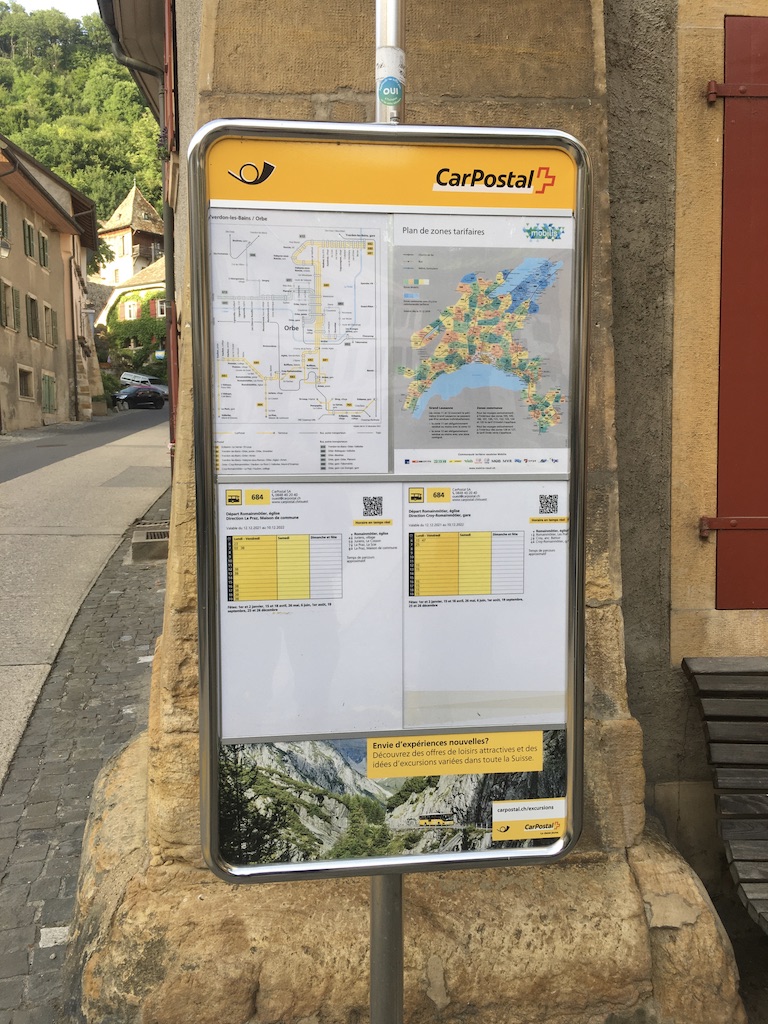
For those reasons, and others, I considered Switzerland an anomaly, hardly a model to be extrapolated to other nations. But I see its fantastic non-car transport options have a lot to teach the world.
I was staying near a village with a population of 780 in the canton of Vaud, in the foothills of the Jura Mountain. To get there from the #Geneva airport, I hopped on to a high-speed train, an escalator ride away from the baggage carousel... 

Departures every 10 minutes or so, along the lakeshore of Lac Léman, to #Lausanne, #Vevey, #Montreux. Downtown #Geneva is *six minutes* away from the airport by train. Many of the trains have kids' playrooms on the upper levels. And of course you can take on a bicycle... 

I changed trains in #Morges, leaving the SBB network (state rail) for a smaller, private network called MBC, which stands for Morges-Bière-Cossonay, after 3 towns it serves. This is the system I got to know best, and it astonished me... 

I changed trains in Apples, which has a population of 1,220. It's a branch point for trains to L'Isle (pop. 900) and Bière (1,400)... 

This train stops at villages along the way, spaced about 2 to 3 miles apart…but many stops are request only. If you don’t buzz, the driver skips the stop…
I arrived in the station of Montricher, which is straight out of the 1950s...and has a quite useful outhouse... 





The train went on to L'Isle. Here's the thing: there was a bus waiting for me and the handful of passengers on the train, which then took us uphill about a mile to the village of Montricher, making a half dozen stops + delivering me to my door... 

You could also get off at the Parc Jura Vaudois, the regional park in the Jura Mountains, where you can hike (or cycle) for hours. As the late Paul Mees pointed out in Transport for Suburbia, transit in #Switzerland serves places whose population density is essentially 0... 



The crazy thing, for a North American, is the reliability, frequency, and esp. *span* of service. I could get on the train from 6 in the morning to almost 2 am. Here's the schedule: 

This overachieving rural transit company, MBC, also ran buses to local schools, in the morning and afternoon... 

Often there weren't many people on the trains. Farebox obviously wasn't a big revenue generator. I asked how they kept going. Turns out they make a lot of money transporting goods and supplies, for example, feed to farms, loads of gravel... 

They also serve a village near one of Switzerland's larger military bases. I often rode the trains with soldiers in fatigues carrying machine guns. The trains also transport tanks to prevent wear-and-tear on local roads. 

They also generate revenue by running vintage trains where you get served wine, burgers and beer, alpine cheese...I took one, it was a fantastic three-course meal in vintage carriages, some from the 1890s... 





As I said, #Switzerland is a rich nation. People can afford cars. But car ownership is surprisingly low: 604 vehicle per 1,000 population, vs. 756 in Italy and 837 in the US. With transit options this good, you don't need to rely on cars. And gas is now $8.65/gallon here... 

There's more to this 🧵, but I've got to run...à demain.
One last point though—an active rural public transportation network also feeds and maintains a healthy, vibrant, and prosperous farming system—and makes it possible for people of all ages to live, work, and go to school in a rural setting.
Transport in #Switzerland 🧵🇨🇭 continued...
The train system is rightfully legendary. They conquered mountains, long ago. I booked a 2nd class ticket out of Montreux and got a seat on the Belle-Epoque, a recreation of a 19th-cent. carriage (but with air-con!)

The train system is rightfully legendary. They conquered mountains, long ago. I booked a 2nd class ticket out of Montreux and got a seat on the Belle-Epoque, a recreation of a 19th-cent. carriage (but with air-con!)


There are InterCity trains (fast, long-distance, often two decks); InterRegio (connect adjacent cantons); RegioExpress; S-Bahn (suburban lines, 12 of them in the country, like high-functioning US commuter rail) and Regio (local trains, make all the stops) 

Almost all of the trains are run by electricity. Starting the 19th cent., #Switzerland undertook one of history’s great feats of hydrology, building dams, linking lakes, whose levels can be raised or dropped at will. 56% of electricity is from hydro
(On the downside, 35% is from nukes, and there’s a lot if resistance to wind here, mostly b/c of concerns about potential impact on farmland—there are not a lot of wide open spaces here) 

So, trains, fantastic, as expected. But what's amazing for a North American is the robust bus network, which solves the last mile (er, km) problem all over the country. The PostBus system—CarPostal in French—runs on 800 routes, serving villages and rural stops... 



Places that aren't served by some private network like MBC (see above) can count on PostBus service. Which is run by the post office—that little clarion horn is its symbol. The buses have right of way on mountain roads, and are known for their haunting 3-toned Dreiklanghorn...
Some of the reasons I decided not to include #Switzerland in #Straphanger:
🇨🇭It's a rich nation.
🇨🇭With its mountains, lack of coastlines, it's a geographical oddity. Central, but also isolated.
🇨🇭Small: 8m people, about pop. of #Quebec.
🇨🇭Not a model of (global) diversity
🇨🇭It's a rich nation.
🇨🇭With its mountains, lack of coastlines, it's a geographical oddity. Central, but also isolated.
🇨🇭Small: 8m people, about pop. of #Quebec.
🇨🇭Not a model of (global) diversity
(Just revising the above b/c people have pointed out 25% of Swiss are foreign-born. Hmmm. Deserves unpacking...but definitely another discussion!)
Another thing that encourages transit use. The SBB (state rail) app is fantastic! My friend Pierre demonstrates. Swipe from your current location to a destination, and it lists upcoming departures…
You can pick the train you want (or buy a ticket that gives you a 24-hour slot to make the point-to-point trip). I used EasyRide a lot. You just get on a train, swipe right, and it calculates the cheapest available fare… 

When you finish your trip, which can of course involve a few connections, you swipe left, the trip ends, and your credit card gets charged via the app. Even if you forget to swipe, the GPS figures out you’ve stopped moving on a train and charges accordingly.
It’s not just the SBB trains that are covered by the app, by the way. It also allows you to travel on the myriad of private, regional bus, tram, train, ferry systems that connect to the state network. 



I spent every day on a bicycle in Switzerland (road bike and e-bike), though cycling clearly isn't as important a mode as it is in Holland, Denmark. A lot of great initiatives, though. Where I was staying, the local electric company let you use e-bikes at rural train stations. 

A takeaway from 6 weeks in rural #Switzerland: Companies here deploy (great!) imagination to generate revenue, but transit definitely has to be publicly subsidized. It’s looked upon as a public good. It keeps rural communities alive, and the rural economy functioning.
And that’s a lesson from #Switzerland—which has one of the world’s most robust and sustainable agricultural economies—that the rest of the world can definitely benefit from. 🇨🇭
• • •
Missing some Tweet in this thread? You can try to
force a refresh


















